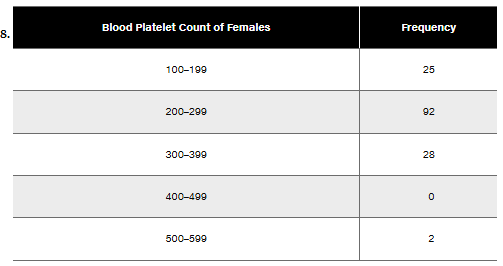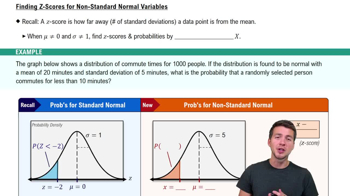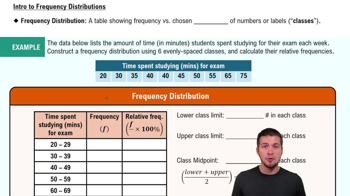Presidents Listed below are the ages (years) of presidents of the United States at the times of their first inaugurations (from Data Set 22 “Presidents” in Appendix B). Presidents who took office as a result of an assassination or resignation are not included. The data are current as of this writing. Use these ages to construct a frequency distribution. Use a class width of 5 years and begin with a lower class limit of 40 years. Do the ages appear to have a normal distribution?
Table of contents
- 1. Intro to Stats and Collecting Data1h 14m
- 2. Describing Data with Tables and Graphs1h 55m
- 3. Describing Data Numerically2h 5m
- 4. Probability2h 16m
- 5. Binomial Distribution & Discrete Random Variables3h 6m
- 6. Normal Distribution and Continuous Random Variables2h 11m
- 7. Sampling Distributions & Confidence Intervals: Mean3h 23m
- Sampling Distribution of the Sample Mean and Central Limit Theorem19m
- Distribution of Sample Mean - Excel23m
- Introduction to Confidence Intervals15m
- Confidence Intervals for Population Mean1h 18m
- Determining the Minimum Sample Size Required12m
- Finding Probabilities and T Critical Values - Excel28m
- Confidence Intervals for Population Means - Excel25m
- 8. Sampling Distributions & Confidence Intervals: Proportion1h 12m
- 9. Hypothesis Testing for One Sample3h 29m
- 10. Hypothesis Testing for Two Samples4h 50m
- Two Proportions1h 13m
- Two Proportions Hypothesis Test - Excel28m
- Two Means - Unknown, Unequal Variance1h 3m
- Two Means - Unknown Variances Hypothesis Test - Excel12m
- Two Means - Unknown, Equal Variance15m
- Two Means - Unknown, Equal Variances Hypothesis Test - Excel9m
- Two Means - Known Variance12m
- Two Means - Sigma Known Hypothesis Test - Excel21m
- Two Means - Matched Pairs (Dependent Samples)42m
- Matched Pairs Hypothesis Test - Excel12m
- 11. Correlation1h 6m
- 12. Regression1h 50m
- 13. Chi-Square Tests & Goodness of Fit1h 57m
- 14. ANOVA1h 57m
2. Describing Data with Tables and Graphs
Frequency Distributions
Problem 2.1.12
Textbook Question
In Exercises 9–12, using a loose interpretation of the criteria for determining whether a frequency distribution is approximately a normal distribution, determine whether the given frequency distribution is approximately a normal distribution. Give a brief explanation.
Blood Platelet Counts of Females Refer to the frequency distribution from Exercise 8

 Verified step by step guidance
Verified step by step guidance1
Step 1: Review the frequency distribution table provided. The table lists blood platelet counts of females in intervals (100–199, 200–299, etc.) along with their corresponding frequencies.
Step 2: Check for symmetry in the distribution. A normal distribution typically has frequencies that increase to a peak and then decrease symmetrically. Observe whether the frequencies rise to a peak and then fall off in a balanced manner.
Step 3: Identify the peak frequency. In this case, the interval 200–299 has the highest frequency (92). Compare the frequencies of intervals on either side of the peak to see if they decrease symmetrically.
Step 4: Look for gaps or irregularities. Note that the interval 400–499 has a frequency of 0, which disrupts the smooth decline expected in a normal distribution. This gap suggests the distribution may not be normal.
Step 5: Consider the shape of the distribution. Based on the frequencies, the distribution appears skewed rather than bell-shaped, as the frequencies do not decrease symmetrically around the peak. Provide an explanation that the distribution is not approximately normal due to the lack of symmetry and the presence of gaps.
 Verified video answer for a similar problem:
Verified video answer for a similar problem:This video solution was recommended by our tutors as helpful for the problem above
Video duration:
2mPlay a video:
Was this helpful?
Key Concepts
Here are the essential concepts you must grasp in order to answer the question correctly.
Normal Distribution
A normal distribution is a probability distribution that is symmetric about the mean, showing that data near the mean are more frequent in occurrence than data far from the mean. It is characterized by its bell-shaped curve, where the mean, median, and mode are all equal. Understanding this concept is crucial for determining if a frequency distribution approximates normality.
Recommended video:
Guided course

Finding Z-Scores for Non-Standard Normal Variables
Frequency Distribution
A frequency distribution is a summary of how often each value occurs in a dataset. It displays the number of occurrences (frequency) of each category or range of values. Analyzing the frequency distribution helps in visualizing the data and assessing its shape, which is essential for evaluating whether it resembles a normal distribution.
Recommended video:
Guided course

Intro to Frequency Distributions
Criteria for Normality
The criteria for determining if a distribution is approximately normal include assessing the symmetry of the distribution, the presence of a single peak (unimodality), and the tails of the distribution. A common method is to use graphical representations like histograms or Q-Q plots, as well as statistical tests. These criteria help in making informed judgments about the normality of the data.
Recommended video:
Guided course

Finding Z-Scores for Non-Standard Normal Variables

 6:38m
6:38mWatch next
Master Intro to Frequency Distributions with a bite sized video explanation from Patrick
Start learningRelated Videos
Related Practice
Textbook Question
